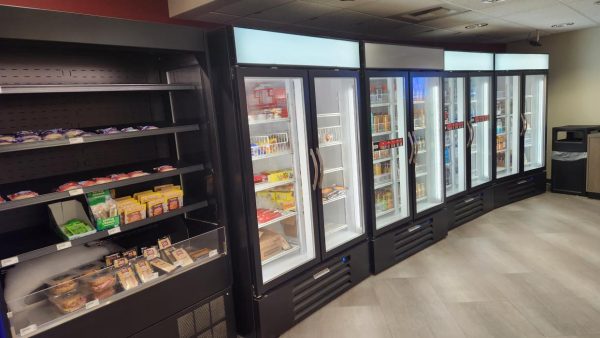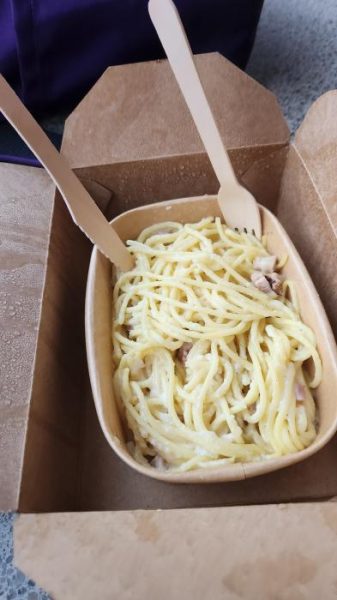Glendale Community College’s spring semester is well underway, and students have settled into their routines of classwork, socializing, homework, repeat. But though there are dozens of different majors represented on campus, all taking different paths to their destination, there’s a universal thread that connects everyone at GCC: Food. Everyone has to eat, whether programmer or musician or writer. Yet the on-campus food offerings leave something to be desired.
Vending machines dot the campus at key choke points to offer sweets, sodas, and snacks, but when it’s time for something more filling, only a few places stand out on campus: The Great White Hut, a burgers and fries chain built into the side of the Cimmarusti Science Center; Starbucks, the fast-food coffee chain in the Learning Commons; and the food truck parked outside the Tongva building. Until early evening, the GCC Bookstore offers frozen treats and sandwiches. Just outside campus, across the bridge, are more restaurants – including a second Starbucks – and we’re only a short bus ride from downtown Glendale if nothing on-campus satisfies the palate and you have the money.

But for students who can’t travel, the common complaint is simple: It’s impossible to find a healthy meal on campus, and students who can’t eat off-campus feel they’re being price-gouged.
Once the GCC Bookstore closes at 4 p.m. and one-dollar PB&Js are no longer available, the average price of food drastically rises as students are forced to engage with the on-campus chains. Dylan, a CompSci major, described the restaurants as “border[ing] on predatory.” Prices are high at the on-campus chains, with most meals being upwards of seven dollars. “I feel like often the price doesn’t match the portions,” said another student about the food truck, describing it as “too expensive for community college students.” Students say high prices are impacting their ability to pay for their college needs such as books, too; When your dinner on campus is costing $50 a week, notebooks become far less tempting of a purchase. The same student described how he stays late for classes, and “around dinner time, my options are across the street or a horrible vending machine.”
Said vending machine, the Foodture food vendor on the first floor of the Sierra Vista building, was a particular sore spot among students. “I curse it for being stupid and a glorified microwave,” one student lamented. “It genuinely sucks,” added another, describing the food as “foul.” For research purposes – and being stuck hungry on campus for late classes – I ventured to this Foodture machine myself to see if it was as bad as claimed. What I saw was a garish device sharing pessimistic messages about an imagined future – where robots have taken everyone’s jobs, and the body is full of microplastics, but would I also like to purchase a pasta carbonara for $11? I said yes, as a last resort.
What I received was a freshly microwaved box of flavorless noodles, still sweating from having been just thawed and overly salted. I forced myself through it, thinking about the delicious macaroni and cheese I could have made at home for the same price – or less.

Food quality was a major issue among other students, not just myself. The Great White Hut was mentioned as being “too [expletive] greasy,” and multiple students offered unverified reports that the food truck undercooks their food. There are minimal healthy options on-campus, with many options being greasy food like pizza and fries, or processed and reheated meals. Salads are nowhere to be found; if you need a staple food like eggs, it’s most likely going to be wrapped in a tortilla or microwaved between two biscuits. Sure, it’s delicious, but students wanting to watch their weight or their nutrition are coming up short. A music major, Serafina, mentioned struggling to meet her dietary needs on campus.
The infrastructure already exists for campus-provided food. A cafeteria lays dormant next to the multicultural center, lights off and silent. There are no vending machines and no cooks – only a microwave by the door and a blocked-off serving line. Where once it might have been a place for students to find low-cost healthy meals, it’s since been reserved for rentals. Its loss is felt. One student expressed a desire for the campus to become involved with meals again, saying if the campus were to offer healthy alternatives, “it would whip the competition into shape.” Occasional free hot dogs in the plaza simply aren’t good enough.
The current food options are inadequate for the student body at large, particularly hurting those on budgets or with dietary restrictions. Something must be done. Students are being starved of choices and funneled to eateries which are hurting their stomachs and their wallets. Hunger isn’t something to power through – students can’t study when starving. When eating on-campus is made so inaccessible, the only recourse is to prepare something at home. But what about those who can’t? What about students who have to find meals on campus? As it stands, unless something is done to meet their needs, those students will be left hungering for more.
